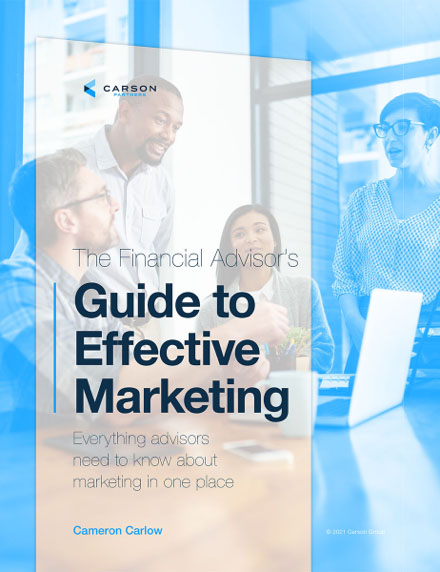SEO – such a simple abbreviation, yet so important to growing a business in the 21st century. Clawing your way to the front page of Google results when someone searches “financial advisor [your city]” takes time and strategy, but it’s worth it.
Consider the following:
- Sites on the first page of Google results get 91 percent of the traffic. Think about it: when was the last time you clicked to Page 2 of search results? The second page is basically the back of your freezer – you know there’s stuff there, but you never really bother looking.
- You might be thinking, “Well, I can just pay for a Google ad and get on the first page.” True, those ads are effective, but 51 percent of traffic goes to organic results, as opposed to 10 percent for paid. Most people skip the ads.
- Seventy-six percent of people who research a business online will then visit that business within a day, with 28 percent resulting in a purchase decision.
- It’s no wonder the majority of American businesses are spending close to $5,000 per month on SEO.
A good SEO strategy is an essential piece of any financial advisor’s success, but it is often either executed poorly or completely ignored. SEO tactics will provide value to all aspects of your advisor marketing and leave you better able to attract new prospects and clients. With that in mind, here are a few quick recommendations to improve your site’s SEO through your blog.
1. Download an SEO Plugin
There are several SEO plugins that can help optimize your pages. Personally, we’re big fans of Yoast (we run it on our own site and all Carson Partners sites, too). It’s easy to use and comes with a built-in SEO grading tool that tells you how well you’re doing.
2. Use Keywords in Key Places
One of the best tools to developing SEO-rich content is a list of keywords (specific phrases or questions that potential clients and prospects would use when searching for you or financial advice). These may be things like, “When to claim Social Security,” “When can I retire?,” or “How much money do I need to retire.” Google Keyword Planner is a useful resource in helping you build out this important list.
Click here to read the story of how Wise Counsel, a firm in Texas, got to the front page of Google.
Once you have your keywords, you’ll want to write your blogs around those ideas. That order is important, as SEO is often an afterthought when content has already been written. It can be difficult to cram keywords into a finished blog, but if you start with the keyword in mind, it will be more natural.
As you’re writing, do your best to include your chosen keyword in the title, headers, first paragraph, meta description, and image alt tags (more on these last two items later). Now, I say “do your best” to do these things. Don’t overdo it. Readability takes priority every time. If your content sounds unnatural, no one’s going to read it (and Google’s bots have been designed to watch out for this practice, known as “keyword stuffing”).
PRO TIP: Be specific with your keywords. Avoid using generic terms like “social security” or “retirement planning.” Instead, think about what people type into Google when researching a question. Use phrases like, “Does it matter when I claim Social Security” or “When should I start planning for retirement.”
3. Include Headers
Headers not only make your content easier to read by breaking it up into digestible sections, they also make it easier for search bots to identify what your posts are about.
For example, writing an entire blog post on the the most recent market rally may be a lengthy and complex endeavor, but breaking it up into simplified section headers of “What Happened in the Market,” “How Things Have Changed (or stayed the same),” and “What to Expect Going Forward” can lead to a more simplified explanation and better search results.
PRO TIP: It’s not enough to just bold the text you’re using as a header. When you post your blog, make sure to format the headers as “Heading 1,” “Heading 2” or another Header setting to differentiate them from the rest of your copy. These Header settings are maintained globally for your site, which not only helps the search bots, it also ensures that your site is consistent and cohesive.
4. Get Meta
The meta description is that little description of an article or page that shows up under the link in search results. Describe the basic point of your article in 160 characters or fewer, then insert it as the meta description for your post. Include your keywords when possible.
PRO TIP: Google actually cuts off meta descriptions at different lengths depending on whether a person is on their phone or a computer. To make sure you’re not too long, use this handy meta description checker from Spotibo. Mobile: 122 characters Desktop: 163 characters
5. Add an Alt Tag to Your Images
Adding an image to each blog post drastically improves its chances of catching people’s eyes and garnering clicks on social media, but an alt tag can help your images stand out to search bots. This is the sub text read by computers as the description of your picture. Describe what the image shows and do your best to fit your keywords in there too. Using general keywords such as financial advice or financial planning along with the title of the post will go a long way to promoting the image and post, but don’t go overboard. Keep it to one sentence.
6. Link to Other Pages (Both Internally and Externally)
As you write, make sure you link to other sites that you reference, even if they’re your own. Internal and external links will do SEO wonders for your advisor marketing.
Internal On the new post, link to old articles and other pages on your site. Then go back to old blog posts and link to the new one. That last bit is the part most people fail to do, but it helps quite a bit when Google sees that you are building a web of internal links.
External Providing external links to your topic or data to support your blog post is important as it gives credibility and educates the reader on the initial idea. Linking people away from your site can feel a little strange, but the more you interact with the outside world, the more likely they are to link back up to you. In addition, it makes Google really happy when they see you playing nice with other websites.
So that’s it. Working on incorporating these six recommendations into every one of your blog posts and your overall advisor marketing will give you a much better chance of maximizing your search ranking, driving traffic to your site, and ultimately leading to more prospects and clients.


